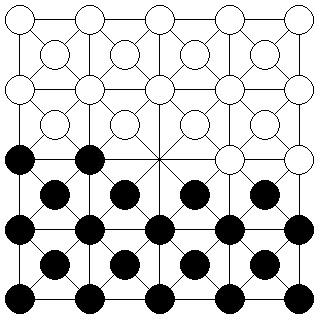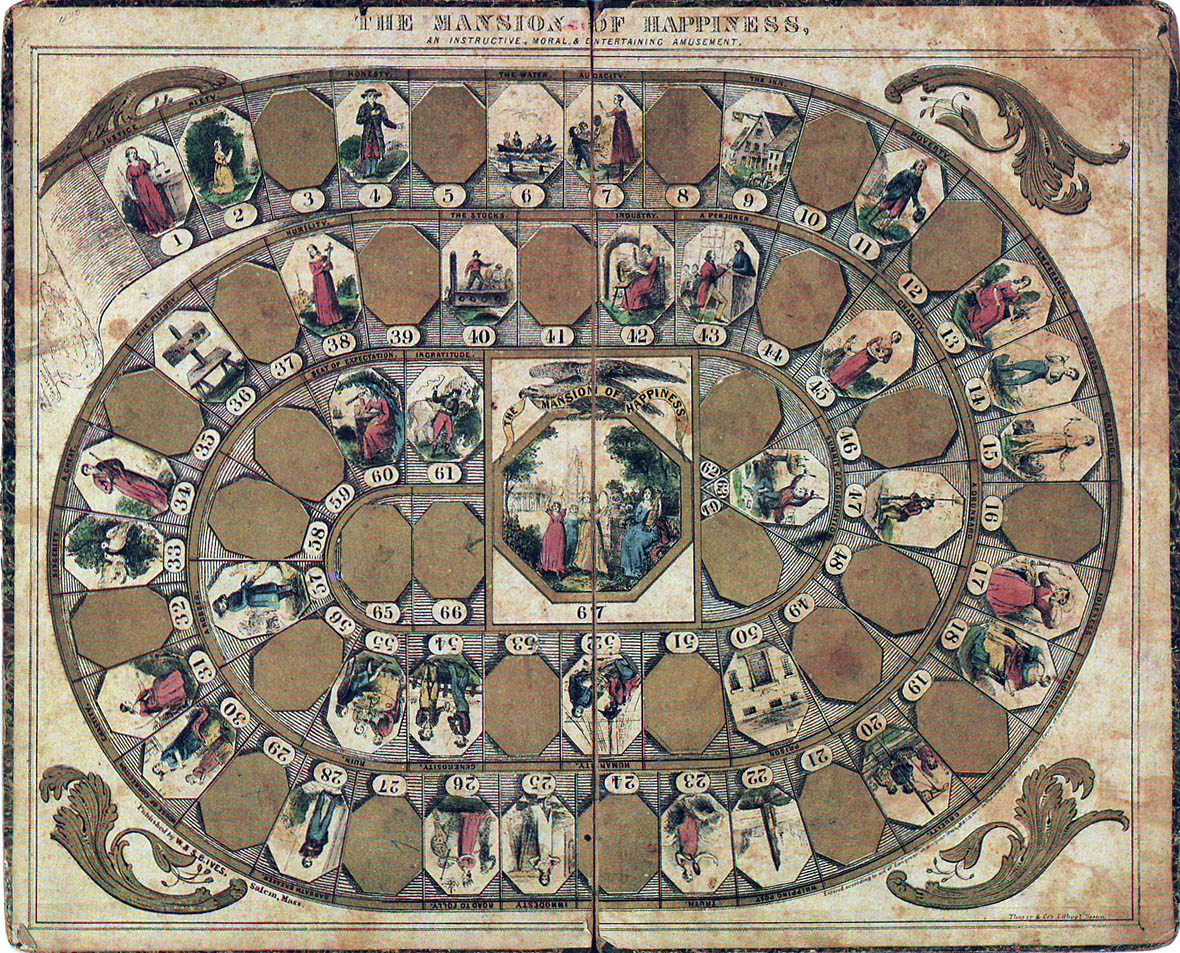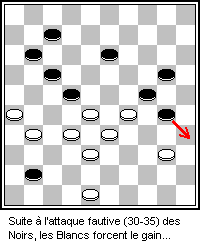|
Tukvnanawopi
{{no footnotes, date=December 2008 Tûkvnanawöpi is a two-player abstract strategy board game played by the Hopi native American Indians of Arizona, United States. The game was traditionally played on a slab of stone, and the board pattern etched on it. Tukvnanawopi resembles draughts and Alquerque. Each player attempts to capture each other's pieces by hopping over them. It is unknown how old the game is; however, the game was published as early as 1907 in Stewart Culin's book "Games of the North American Indians Volume 2: Games of Skill". A similar game (with a similar name) also played by the Hopi is Tuknanavuhpi. The only difference is that in Tuknanavuhpi lines of intersection points become unplayable as opposed to rows or columns of squares in Tukvnanawopi when the game progresses. Rule #7 under the Game Play and Rules section elaborates on this. Another similar game is played by the Keres native American tribe in New Mexico called Aiyawatstani. Lastly, the game is al ... [...More Info...] [...Related Items...] OR: [Wikipedia] [Google] [Baidu] |
Tuknanavuhpi
''Tuknanavuhpi is a two-player abstract strategy board game played by the Hopi Native American Indians of Arizona, United States. It is also played in many parts of Mexico. The game was traditionally played on a slab of stone with the board pattern etched on it. Tukvnanawopi resembles draughts and Alquerque. Players attempt to capture each other's pieces by hopping over them. It is not known when the game was first played; however, the game was published as early as 1907 in Stewart Culin's book ''Games of the North American Indians Volume 2: Games of Skill''. A similar game (with a similar name) also played by the Hopi is Tukvnanawopi. The only differences are that in Tuknanavuhpi lines of intersection points become unplayable as opposed to rows or columns of squares in Tukvnanawopi, and that in Tukvnanawopi there can be two or four players. (A more elaborate description is provided in the Game Play and Rules section.) Another similar game called Aiyawatstani is played by the K ... [...More Info...] [...Related Items...] OR: [Wikipedia] [Google] [Baidu] |
Abstract Strategy
Abstract strategy games admit a number of definitions which distinguish these from strategy games in general, mostly involving no or minimal narrative theme, outcomes determined only by player choice (with no randomness), and perfect information. For example, Go is a pure abstract strategy game since it fulfills all three criteria; chess and related games are nearly so but feature a recognizable theme of ancient warfare; and Stratego is borderline since it is deterministic, loosely based on 19th-century Napoleonic warfare, and features concealed information. Definition Combinatorial games have no randomizers such as dice, no simultaneous movement, nor hidden information. Some games that do have these elements are sometimes classified as abstract strategy games. (Games such as '' Continuo'', Octiles, '' Can't Stop'', and Sequence, could be considered abstract strategy games, despite having a luck or bluffing element.) A smaller category of abstract strategy games manages to i ... [...More Info...] [...Related Items...] OR: [Wikipedia] [Google] [Baidu] |
Board Game
Board games are tabletop games that typically use . These pieces are moved or placed on a pre-marked board (playing surface) and often include elements of table, card, role-playing, and miniatures games as well. Many board games feature a competition between two or more players. To show a few examples: in checkers (British English name 'draughts'), a player wins by capturing all opposing pieces, while Eurogames often end with a calculation of final scores. '' Pandemic'' is a cooperative game where players all win or lose as a team, and peg solitaire is a puzzle for one person. There are many varieties of board games. Their representation of real-life situations can range from having no inherent theme, such as checkers, to having a specific theme and narrative, such as ''Cluedo''. Rules can range from the very simple, such as in snakes and ladders; to deeply complex, as in ''Advanced Squad Leader''. Play components now often include custom figures or shaped counters, and distin ... [...More Info...] [...Related Items...] OR: [Wikipedia] [Google] [Baidu] |
Hopi
The Hopi are a Native American ethnic group who primarily live on the Hopi Reservation in northeastern Arizona, United States. As of the 2010 census, there are 19,338 Hopi in the country. The Hopi Tribe is a sovereign nation within the United States and has government-to-government relations with the United States federal government. Particular villages retain autonomy under the Hopi Constitution and Bylaws. The Hopi language is one of 30 in the Uto-Aztecan language family. The majority of Hopi people are enrolled in the Hopi Tribe of Arizona but some are enrolled in the Colorado River Indian Tribes. The Hopi Reservation covers a land area of . The Hopi encountered Spaniards in the 16th century, and are historically referred to as Pueblo people, because they lived in villages (''pueblos'' in the Spanish language). The Hopi are thought to be descended from the Ancestral Puebloans ( Hopi: ''Hisatsinom''), who constructed large apartment-house complexes and had an advanced cu ... [...More Info...] [...Related Items...] OR: [Wikipedia] [Google] [Baidu] |
Native American Indians
Native Americans, also known as American Indians, First Americans, Indigenous Americans, and other terms, are the Indigenous peoples of the mainland United States (Indigenous peoples of Hawaii, Alaska and territories of the United States are generally known by other terms). There are 574 federally recognized tribes living within the US, about half of which are associated with Indian reservations. As defined by the United States Census, "Native Americans" are Indigenous tribes that are originally from the contiguous United States, along with Alaska Natives. Indigenous peoples of the United States who are not listed as American Indian or Alaska Native include Native Hawaiians, Samoan Americans, and the Chamorro people. The US Census groups these peoples as " Native Hawaiian and other Pacific Islanders". European colonization of the Americas, which began in 1492, resulted in a precipitous decline in Native American population because of new diseases, wars, ethnic cleansing, a ... [...More Info...] [...Related Items...] OR: [Wikipedia] [Google] [Baidu] |
Arizona
Arizona ( ; nv, Hoozdo Hahoodzo ; ood, Alĭ ṣonak ) is a state in the Southwestern United States. It is the 6th largest and the 14th most populous of the 50 states. Its capital and largest city is Phoenix. Arizona is part of the Four Corners region with Utah to the north, Colorado to the northeast, and New Mexico to the east; its other neighboring states are Nevada to the northwest, California to the west and the Mexican states of Sonora and Baja California to the south and southwest. Arizona is the 48th state and last of the contiguous states to be admitted to the Union, achieving statehood on February 14, 1912. Historically part of the territory of in New Spain, it became part of independent Mexico in 1821. After being defeated in the Mexican–American War, Mexico ceded much of this territory to the United States in 1848. The southernmost portion of the state was acquired in 1853 through the Gadsden Purchase. Southern Arizona is known for its desert cl ... [...More Info...] [...Related Items...] OR: [Wikipedia] [Google] [Baidu] |
Draughts
Checkers (American English), also known as draughts (; British English), is a group of strategy board games for two players which involve diagonal moves of uniform game pieces and mandatory captures by jumping over opponent pieces. Checkers is developed from alquerque. The term "checkers" derives from the checkered board which the game is played on, whereas "draughts" derives from the verb "to draw" or "to move". The most popular forms of checkers in Anglophone countries are American checkers (also called English draughts), which is played on an 8×8 checkerboard; Russian draughts, Turkish draughts both on an 8x8 board, and International draughts, played on a 10×10 board – the latter is widely played in many countries worldwide. There are many other variants played on 8×8 boards. Canadian checkers and Singaporean/Malaysian checkers (also locally known as ''dum'') are played on a 12×12 board. American checkers was weakly solved in 2007 by a team of Canadian computer s ... [...More Info...] [...Related Items...] OR: [Wikipedia] [Google] [Baidu] |
Alquerque
Alquerque (also known as Qirkat from ar, القرقات) is a strategy board game that is thought to have originated in the Middle East. It is considered to be the parent of draughts (US: checkers) and Fanorona. History The game first appears in literature late in the 10th century when Abu al-Faraj al-Isfahani mentioned Qirkat in his 24-volume work ''Kitab al-Aghani'' ("Book of Songs"). This work, however, made no mention of the rules of the game. In '' Board and Table Games from Many Civilizations'', R. C. Bell writes that "when the Moors invaded Spain they took El-quirkat with them". Rules are included in ''Libro de los juegos'' ("Book of games") commissioned by Alfonso X of Castile in the 13th century. Spanish settlers in New Mexico introduced a four-player variant of Alquerque to the Zuni. Rules 250px, An empty abstract Alquerque board upright=1.75, This board graphic displays Moorish design elements relating to the origin of Alquerque. The algebraic notation faci ... [...More Info...] [...Related Items...] OR: [Wikipedia] [Google] [Baidu] |
Kharbaga
Kharbaga is a two-player abstract strategy game from North Africa. In a way, it is a miniature version of Zamma; however, there are more diagonal lines per square on the board as compared to Zamma. The game is considered part of the Zamma family. The game is also similar to Alquerque and draughts. The board is essentially an Alquerque board with twice the number of diagonal lines or segments allowing for greater freedom of movement. The initial setup is also similar to Alquerque, where every space on the board is filled with each player's pieces except for the middle point of the board. Moreover, each player's pieces are also set up on each player's half of the board. The game specifically resembles draughts in that pieces must move in the forward directions until they are crowned " Mullah" (or "Sultan") which is the equivalent of the King in draughts. The Mullah can move in any direction. It is unknown how old the game is; however, the idea that pieces must move forward until they ... [...More Info...] [...Related Items...] OR: [Wikipedia] [Google] [Baidu] |
Draughts
Checkers (American English), also known as draughts (; British English), is a group of strategy board games for two players which involve diagonal moves of uniform game pieces and mandatory captures by jumping over opponent pieces. Checkers is developed from alquerque. The term "checkers" derives from the checkered board which the game is played on, whereas "draughts" derives from the verb "to draw" or "to move". The most popular forms of checkers in Anglophone countries are American checkers (also called English draughts), which is played on an 8×8 checkerboard; Russian draughts, Turkish draughts both on an 8x8 board, and International draughts, played on a 10×10 board – the latter is widely played in many countries worldwide. There are many other variants played on 8×8 boards. Canadian checkers and Singaporean/Malaysian checkers (also locally known as ''dum'') are played on a 12×12 board. American checkers was weakly solved in 2007 by a team of Canadian computer s ... [...More Info...] [...Related Items...] OR: [Wikipedia] [Google] [Baidu] |

_--_2021_--_6741.jpg)




